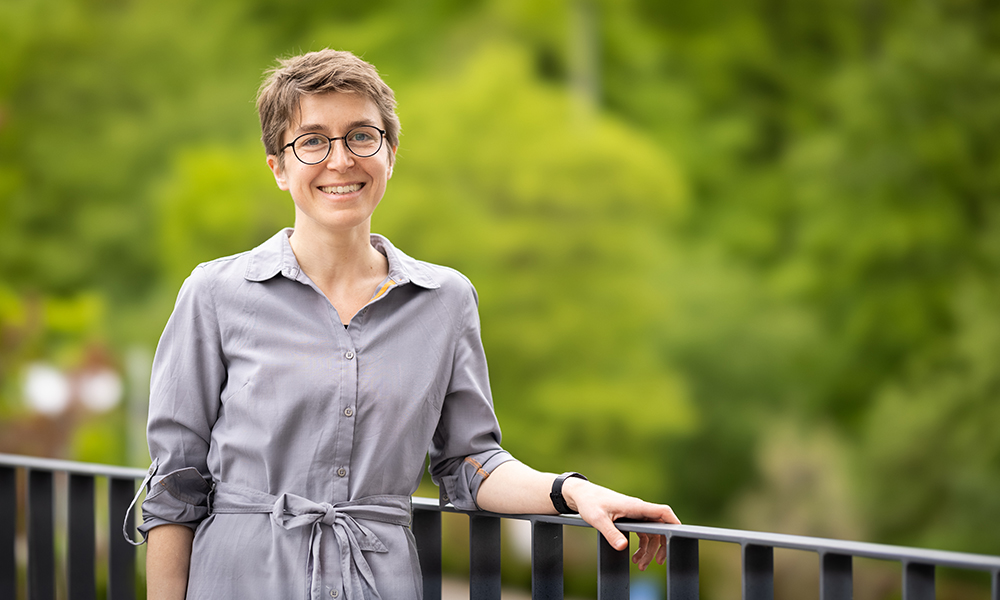
Read the latest Issue
One of EMBL’s newest group leaders explains how steam engines and musical instruments led her to a career in biophysics

With a background in the physics of complex systems and a philosophy that physics is everywhere, new EMBL group leader Anna Erzberger looks forward to collaborating with other researchers at EMBL.
We ask where biological forms come from – how it works that smaller components come together, interact with each other, and give rise to larger structures. For example, fertilised eggs turn into organisms and cells assemble into organs. Relatively little goes wrong, over and over again, as these processes produce intricate machines that fulfil very precise functions at different scales. My group studies this question from a theoretical physics perspective, which gives us two advantages. First, we can dissect mechanisms that directly involve physics – fluid flow, mechanical deformations, that kind of thing. This is often very interesting physics, where we must account for the active properties of living matter and sort out complex geometries. Second, and perhaps more important, as theorists we can work in a diverse range of contexts, which eventually allows us to make generalisations. We don’t have to restrict ourselves to a particular model organism or a particular protein. We collaborate with experts in different fields. Within a given collaboration, our work produces very concrete quantitative predictions that help resolve particular – more context-specific – biological questions. But our goal is to work out the unifying principles. I would argue that processes that can be understood exclusively on the basis of genes and biochemical interactions are the exception in biology. Much more frequently, an organism’s shape or form – its morphology – and mechanics feeds back to the molecular processes, and it’s these types of feedback that govern phenomena like embryonic development.
Our research requires excellent collaborators. We’re looking forward to working with the fantastic experimental scientists at EMBL, and being part of EMBL’s open and collaborative culture. Also, we feel supported in engaging in a research programme that’s very fundamental. Of course there are potentially far-reaching implications and applications, but it’s recognised that these might unfold over a very long timescale.
I grew up in a home filled with microscopes, steam engines, and musical instruments. Physics is everywhere.
I like to learn, and I like to build abstractions. These are the two things that theoretical biological physicists do all the time. In a given project, we must first understand the problem thoroughly and learn everything we can about the particular system. This includes the science itself but also other constraints, like what experiments are possible in general, and what experiments are feasible within the framework of our collaboration. Then we must think about how to abstract the problem, simplify it, decide what to leave out. The first part is about learning and immersing yourself in the problem, and if you don’t do it thoroughly, you can’t do the second step well. And that step is a truly creative process. You must find a sweet spot where a theory is simple enough that you can still keep track of it, but also rich enough that it’ll yield new insight. I find that very satisfying.
Not a superpower, but if I could get a skill point boost on anything, I’d like to be funnier. It would be great to make anyone (including myself) laugh any time I want.
I play video games. Slaying zombies is so relaxing.
I loved the books of Gerald Durrell as a kid. I recently reread the Corfu trilogy – it’s still awesome.
I’m very interested in the role of morphology – at cellular and multicellular levels – in guiding morphogenesis – the way morphology develops. I call this a morphological feedback loop, in which form informs its own formation! Biology has many examples of this. With the way imaging technology is developing and enabling the precise, dynamic measurement of shapes, we have a very exciting opportunity as theorists to tackle this type of problem in an experimentally grounded way.
Looking for past print editions of EMBLetc.? Browse our archive, going back 20 years.
EMBLetc. archive